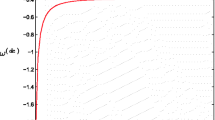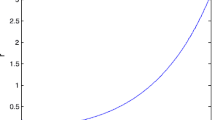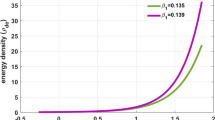Abstract
In this paper, dark energy models of the universe filled with wet dark fluid are constructed in the frame work of LRS Bianchi type-II space-time in General Theory of Relativity. A new equation of state modeled on the equation of state \(p = \gamma ( \rho - \rho_{*} )\), which can describe liquid including water, is used. The exact solutions of Einstein’s field equations are obtained in quadrature form and the models corresponding to the cases \(\gamma = 0\) and \(\gamma = 1\) are discussed in details.
Similar content being viewed by others
Avoid common mistakes on your manuscript.
1 Introduction
The studies of remote type Ia supernova (SNeIa) in 1998 (Perlmutter et al. 1998, 1999; Riess et al. 1998, 2004) suggest that the expansion of the universe is accelerating. This discovery is viewed as a major breakthrough of the observational cosmology as till 1998 it was thought that the universe was expanding with deceleration due to the attraction of the masses within it. The accelerated expansion of the universe can be accounted for by attributing 68.3% (Ade et al. 2014) of the energy density of the universe to a mysterious source of energy, dubbed dark energy (DE) with negative pressure, the true nature of which is still unknown. However, there is no dearth of candidates for DE proposed in literature. Some of them are the Cosmological constant (\(\varLambda\)), Quintessence (Ratra and Peebles 1988; Caldwell 1998), K-essence (Armendariz-Picon et al. 1999, 2001), phantom energy (Caldwell 2002, 2003; Carroll et al. 2003), Chaplygin gas (Kamenshchik et al. 2001) etc. Holman and Naidu (2005) introduced a new candidate for DE, called the wet dark fluid (WDF) with the equation of state (EOS)
where \(p_{w}\) is the pressure, \(\rho_{w}\) the energy density of WDF and the parameters \(\gamma\) and \(\rho_{*}\) are taken to be positive with the restriction \(0< \gamma <1\). Babichev et al. (2005) also proposed a dark energy model with a linear equation of state similar to (1), which is \(p = \alpha ( \rho - \rho_{0})\), where \(\alpha\) and \(\rho_{0}\) are free parameters, to overcome the hydrodynamical instability of the dark energy with the usually used EOS \(p = \omega\rho\) where \(\omega =\) constant \(<0\). They discussed four different types of evolution of the universe depending on the signs of \(1+ \alpha\) and \(\alpha \rho_{0}\). Equation (1) is modeled on an empirical EOS proposed by Tait (1988) and Hayward (1967) to treat water and aqueous solutions. WDF has two components: one of them behaves as the Cosmological constant and the other as standard fluid including water. The second component can be used as dark matter. Thus, WDF unifies the two dark components. Many authors like Singh and Chaubey (2008), Adhab et al. (2010), Chaubey (2009, 2011), Katore et al. (2012), Ravishankar et al. (2013), Chirde and Rahate (2013), Deo et al. (2014), Kandalkar et al. (2014) studied WDF in different contexts.
Though it is believed that our universe is spatially flat, some experimental data have suggested that our present universe is not perfectly flat, but it possesses a small curvature (Bennet et al. 2003; Spergel et al. 2003). In this scenario, Bianchi type metrics are suitable for studying the evolution of the universe as these give anisotropy and ellipsoidality to the universe. However, the Bianchi models isotropize at late times even for ordinary matter. In fact this isotropization is due to the implicit assumption that the DE is isotropic in nature. Bianchi type-II space-time models can be used to construct cosmological models suitable for describing early stages of evolution of the universe. Recently, Pradhan et al. (2011), Kumar and Akarsu (2012), Singh and Kumar (2006), Saha and Yadav (2012) have studied Bianchi type-II models in different contexts.
In this paper, we present cosmological models in the framework of LRS Bianchi type-II space-time with wet dark fluid. We have used the EOS (1) for WDF with the restriction \(0 \leq \gamma \leq 1\). The paper is organized as follows: In Sect. 2 we obtain field equations for LRS Bianchi type-II metric and in Sect. 3, we obtain exact solutions for the field equations in quadrature form. In Sect. 4, we discuss some particular cases of the obtained results together with their physical properties. We conclude the paper with a brief discussion in Sect. 5.
2 Metric and field equations
We consider anisotropic LRS Bianchi type-II metric in the form
where \(A\) and \(B\) are directional scale factors and are functions of cosmic time \(t\) alone.
The Einstein’s field equations are given by
where \(k\) is the gravitational constant and \(T_{ij}\) is the energy-momentum tensor for WDF and is given by
where \(u^{i}\) is the flow vector satisfying
In comoving co-ordinates, the field equations (3) with respect to the metric (2) are found to be
where an over dot denotes differentiation with respect to \(t\).
The equation of continuity is
where \(H\) is the average Hubble parameter given by
The volume expansion parameter \(V\) is given by
The expansion scalar \(\theta\), anisotropy parameter \(\varDelta\), shear scalar \(\sigma^{2}\) and the deceleration parameter \(q\), which is a dimensionless measure of the cosmic acceleration of the expansion of the universe, are defined by
Again, using (1) in (9) with \(H = \frac{1}{3} \frac{\dot{V}}{V}\) and integrating we get
where \(C ( >0 )\) is a constant of integration.
3 The solution of the field equations
Again, from (10)
Equations (9) and (19) with \(H = \frac{1}{3} \frac{\dot{V}}{V}\) yield
which can be put in the form
Now, we have three equations (6)–(8) and four unknown parameters \(A\), \(B\), \(\rho_{w}\) and \(p_{w}\). So, we require one more physical condition relating the parameters to solve the equations completely. For this purpose, we take
which yields
On integration, (28) yields
where \(C_{1}\) is the integration constant and
Equation (29) with (16) yields
where \(t_{0}\) is the integration constant. We may take \(t_{0} =0\) as this will only shift the origin of time.
4 Some particular cases
Case I: \(\gamma = 0\) (dust universe)
Equation (31) reduces to
which yields
Since, \(V\) is positive at \(t = 0\), therefore, \(C_{1} <0\).
We take
Equation (45) shows that \(q \leq 0\) when \(\lvert t \rvert \leq \frac{2 \sqrt{3 C_{3}}}{C C_{2}}\) and \(q >0\) when \(\lvert t \rvert > \frac{2 \sqrt{3 C_{3}}}{C C_{2}}\). \(V\) decreases for \(- \frac{2 \sqrt{3 C_{3}}}{C C_{2}} < t <0\), in spite of \(q\) being negative. But, this is not physically possible. Again, for early inflationary universe, \(q <0\). Hence, the universe starts at \(t =0\) and then expands with acceleration till \(t < \frac{2 \sqrt{3 C_{3}}}{C C_{2}}\) and with deceleration thereafter.
\(A\), \(B\), \(V\) are all finite at \(t = 0\) and increase to \(\infty\) as \(t\) increases to \(\infty\).
\(\rho_{w}\) is finite at \(t = 0\) and decreases to zero as \(t\) increases to \(\infty\).
Since, \(\varDelta \neq 0\) (for \(m \neq 1\)), the universe is anisotropic throughout its evolution although the WDF in it is isotropic.
Case II: \(\gamma = 1\) (Zeldovich fluid)
Equation (31) reduces to
which yields
Subcase II(a)
When \(C_{1} + C C_{2} =0\), we have
\(A\), \(B\), \(V\) are all zero at \(t = -\infty\), unity at \(t = 0\) and infinite at \(t = \infty\).
Since, \(q <0\) for all \(t\), the universe starts from big bang at \(t = -\infty\) and expands with acceleration throughout its evolution. Since, \(\frac{dH}{dt} =0\), in this case the universe has the fastest rate of expansion.
\(\rho_{w}\) and \(p_{w}\) are both infinite at \(t = -\infty\), and decreases to \(\frac{\rho_{*}}{{2}}\) and \(- \frac{\rho_{*}}{{2}}\) respectively as \(t\) increases to \(\infty\).
Since, \(\varDelta \neq 0\) (for \(m \neq 1\)), the universe is anisotropic throughout its evolution.
Subcase II(b)
For \(C_{1} + C C_{2} >0\), we have
Since, \(V\) is negative when \(t < 0\), therefore, \(t \geq 0\) in this case.
But, \(q >0\) when \(0 \leq t < \sqrt{\frac{2}{C_{2} \rho_{*}}} \ln ( \sqrt{3} + \sqrt{2} )\) and \(q <0\) when \(t > \sqrt{\frac{2}{C_{2} \rho_{*}}} \ln ( \sqrt{3} + \sqrt{2} )\). Again, for early inflationary universe \(q <0\). Hence, the universe starts at \(t = t_{0} = \sqrt{\frac{2}{C_{2} \rho_{*}}} \ln ( \sqrt{3} + \sqrt{2} )\) and expands with acceleration throughout its evolution.
\(A\), \(B\), \(V\) are all finite at \(t = t_{0}\), increase with \(t\) and become infinite at \(t = \infty\).
\(\rho_{w}\) and \(p_{w}\) are both finite at \(t = t_{0}\) and decrease to \(\frac{\rho_{*}}{{2}}\) and \(- \frac{\rho_{*}}{{2}}\) respectively as \(t\) increases to \(\infty\).
Since, \(\varDelta \neq 0\) (for \(m \neq 1\)), the universe is anisotropic throughout its evolution.
Subcase II(c)
For \(C_{1} + C C_{2} <0\), we have
\(q <0\) for all \(t\). But, \(A\), \(B\), \(V\) all decrease as \(t\) increases from \(-\infty\) to zero. This is not physically possible. Hence, the universe starts at \(t =0\) and expands with acceleration throughout its evolution.
\(A\), \(B\), \(V\) are all finite at \(t = 0\), increase with \(t\) and become infinite at \(t = \infty\).
\(\rho_{w}\) and \(p_{w}\) are both finite at \(t = 0\) and increase to \(\frac{\rho_{*}}{{2}}\) and \(- \frac{\rho_{*}}{{2}}\) respectively as \(t\) increases to \(\infty\).
Since, \(\varDelta \neq 0\) (for \(m \neq 1\)), the universe is anisotropic throughout its evolution.
5 Conclusions
We study the universe filled with an isotropic wet dark fluid (WDF) obeying the equation of state \(p_{w} = \gamma ( \rho_{w} - \rho_{*} )\) with \(0 \leq \gamma \leq 1\) in the frame-work of LRS Bianchi type-II space-time in General Relativity. The solution of the field equations is obtained in quadrature form. We consider four particular cases corresponding to \(\gamma =0\) and \(\gamma =1\) in detail and discuss some physical properties of the universe represented by the models. It is found that in all the models the geometry of the universe is anisotropic throughout its evolution though the WDF is isotropic. We also find that:
-
(i)
For \(\gamma =0\), since, the EOS parameter \(\omega_{w} = \frac{p_{w}}{\rho_{w}} =0\), the universe contains non-phantom energy throughout its evolution. The universe starts at \(t =0\) and expands with acceleration till \(t < \frac{2 \sqrt{3 C_{3}}}{C C_{2}}\) and then the acceleration changes to deceleration and the universe expands with deceleration till the end. But, since, \(A,B, V\) are all infinite at \(t = \infty\), the universe reaches the big rip and does not reach the big crunch.
Thus, this model is suitable for representing the inflationary universe of the early era and the universe of the matter dominating era.
-
(ii)
For \(\gamma =1\) and \(C_{1} + CC_{2} =0\), since \(\omega_{w} \geq- 1\), the universe contains non-phantom energy. Also, \(\omega_{w} = - 1\) at \(t = \infty\), hence in this case, the WDF behaves like cosmological constant at late times of the universe. The universe starts from the big-bang at \(t = -\infty\) and expands with acceleration throughout its evolution till it reaches the big rip.
Thus, this model is suitable for early and late time accelerated expanding universe.
-
(iii)
For \(\gamma =1\) and \(C_{1} + CC_{2} >0\), since \(\omega_{w} \geq- 1\), the universe contains non-phantom energy. Also, \(\omega_{w} = - 1\) at \(t = \infty\), hence in this case, the WDF behaves like cosmological constant at late times of the universe.
The universe starts at \(t = \sqrt{\frac{2}{C_{2} \rho_{*}}} \ln ( \sqrt{3} + \sqrt{2} )\) and expands with acceleration throughout its evolution till it reaches the big rip.
Thus, this model is suitable for representing the late time accelerated expanding universe.
-
(iv)
For \(\gamma =1\) and \(C_{1} + CC_{2} <0\), since \(\omega_{w} < - 1\) for finite time, the universe contains phantom energy. Also, \(\omega_{w} = - 1\) at \(t = \infty\), hence, the WDF behaves like cosmological constant at late times of the universe. The universe starts at \(t =0\) and expands with acceleration throughout its evolution till it reaches the big rip. Thus, this model is suitable for representing the early time inflationary universe as well as the late time accelerated expanding universe.
References
Ade, P.A.R., et al.: Astron. Astrophys. 571, A1 (2014). arXiv:1303.5062 [astro-ph]
Adhab, K.S., et al.: Adv. Stud. Theor. Phys. 4, 917 (2010)
Armendariz-Picon, C., et al.: Phys. Lett. B 458, 209 (1999)
Armendariz-Picon, C., et al.: Phys. Rev. D 63, 103510 (2001)
Babichev, et al.: Class. Quantum Gravity 22, 143 (2005)
Bennet, C.L., et al.: Astrophys. J. 148, 1 (2003)
Caldwell, R.R.: Phys. Rev. Lett. 80, 1582 (1998)
Caldwell, R.R.: Phys. Lett. B 545, 23 (2002)
Caldwell, R.R.: Phys. Rev. Lett. 91, 071301 (2003)
Carroll, S.M., et al.: Phys. Rev. D 68, 023509 (2003)
Chaubey, R.: Astrophys. Space Sci. 321, 241–246 (2009)
Chaubey, R.: Nat. Sci. 3, 817–826 (2011)
Chirde, V.R., Rahate, P.N.: Glob. J. Sci. Front. Res. XIII, 25–32 (2013)
Deo, S.D., et al.: Adv. Appl. Sci. Res. 5(3), 391–396 (2014)
Hayward, A.T.J.: Br. J. Appl. Phys. 18, 965 (1967)
Holman, R., Naidu, S.: arXiv:astro-ph/0408102v3 (2005)
Kamenshchik, A., et al.: Phys. Lett. B 511, 265 (2001)
Kandalkar, S.P., et al.: Int. J. Inn. Res. Sci. Eng. Tech. 3, 9450–9455 (2014)
Katore, S.D., et al.: Afr. Phys. Rev. 7, 0035 (2012). 305–312
Kumar, S., Akarsu, Ö.: Eur. Phys. J. 127, 64 (2012). arXiv:1110.2408 [gr-qc]
Perlmutter, S., et al.: Nature 391, 51 (1998)
Perlmutter, S., et al.: Astrophys. J. 517, 565 (1999)
Pradhan, A., et al.: Astrophys. Space Sci. 334, 249 (2011)
Ratra, B., Peebles, P.J.E.: Phys. Rev. D 37, 3406 (1988)
Ravishankar, A., et al.: Turk. J. Phys. 37, 166–171 (2013)
Riess, A.G., et al.: Astron. J. 116, 1009 (1998)
Riess, A.G., et al.: Astron. J. 607, 665 (2004)
Saha, B., Yadav, A.K.: Astrophys. Space Sci. 341, 651–656 (2012). arXiv:1110.4887v2 [physics.gen-ph]
Singh, T., Chaubey, R.: Pramana J. Phys. 71, 447–458 (2008)
Singh, C.P., Kumar, S.: Int. J. Mod. Phys. D 15, 419–438 (2006)
Spergel, D.N., et al.: Astrophys. J. Suppl. Ser. 148, 175 (2003)
Tait, P.G.: In: Voyage of HMS Challenger, vol. 2, p. 1. HMSO, London (1988)
Acknowledgements
The authors would like to thank the anonymous reviewer for valuable comments and constructive suggestions.
Author information
Authors and Affiliations
Corresponding author
Rights and permissions
About this article
Cite this article
Mahanta, C.R., Sheikh, A.R. Bianchi type-II universe with wet dark fluid in general theory of relativity. Astrophys Space Sci 362, 154 (2017). https://doi.org/10.1007/s10509-017-3133-9
Received:
Accepted:
Published:
DOI: https://doi.org/10.1007/s10509-017-3133-9




